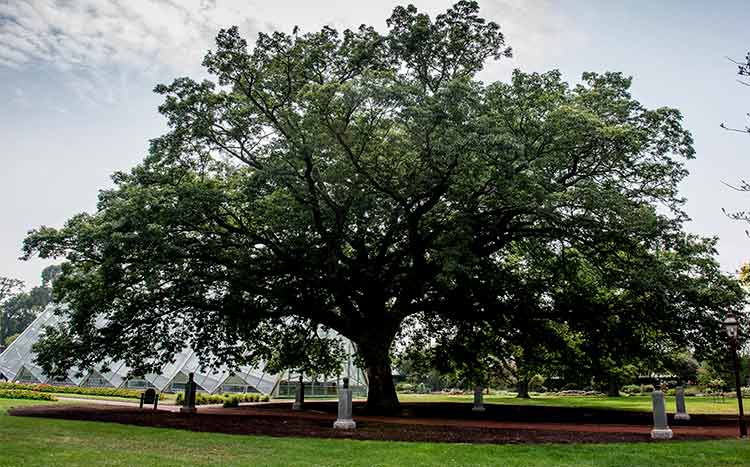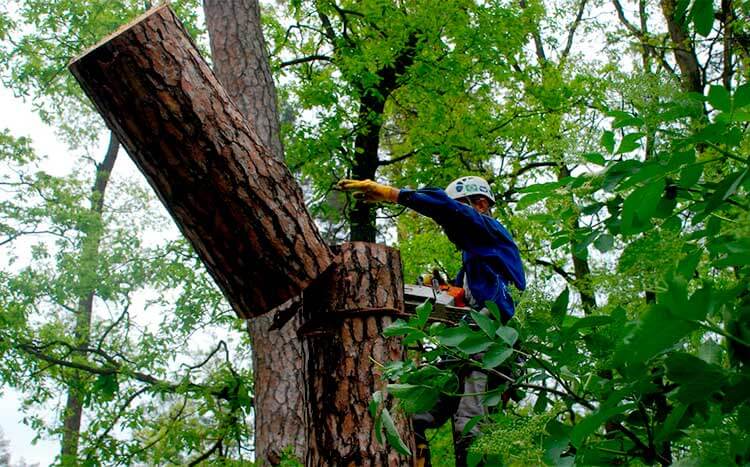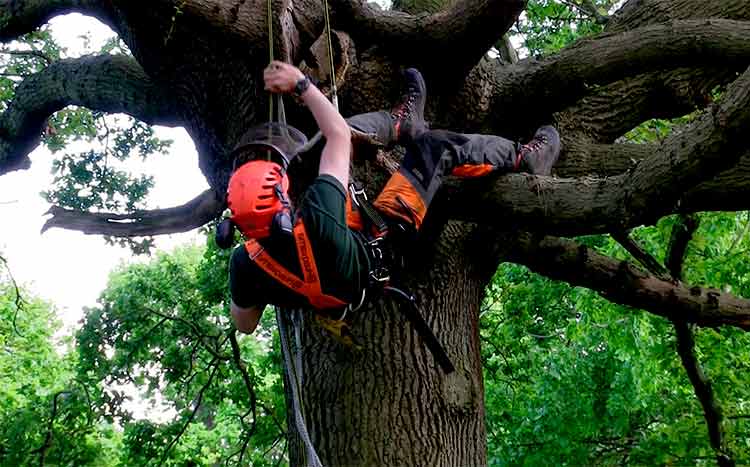Crown reduction is an excellent pruning method1 that prevents trees from growing too tall or large for their environment. It also prevents your tree from breaking during storms and preserves its natural appearance.
Crown reduction involves removing or pruning less than 20 percent of the branches in a tree canopy. It can be performed bi-annually, annually, or every couple of years from winter to early summer, depending on the tree species, growth rate, and growing conditions.
Read on to learn more about how crown reduction can help you keep your trees healthy and safe.

What is tree crown reduction?
Crown reduction is the process of removing (alive, dead, diseased, misaligned, or damaged) branches in a tree crown through reduction cuts either to reduce the crown size or the height of the tree. It is performed to reduce the overall crown area of large, unstable trees. Or improve light penetration through dense crown foliage. Crown reduction is a safer pruning method3 that does not harm the free in the long run because more minor cuts are made during the process, and less than 20 percent of the crown is removed.
Want a shortcut?
The fastest and easiest way to get 3 Estimates from the most affordable tree services near you would be by using this FREE service.
GoTreeQuotes quickly matches you with the 3 tree surgeons voted #1 by previous users in your area.
- Scroll up to the top of the page and enter your ZIP Code in the blue form at the top of the page.
- Give us a few details about your tree trimming or removal job plus some contact information.
- Your tree details are forwarded to the closest three tree services all voted best priced who will also price your tree job.

How often should you perform crown reduction?
You can perform crown reduction either bi-annually or annually on fast-growing trees with heavy foliage to keep the tree within the desired size. Crown reduction should be a continuous exercise that must be done throughout the tree’s lifespan depending on the crown reduction objectives, tree species, growth stage, and growing conditions.
What is the purpose of a tree crown reduction?
Tree owners perform crown reduction to achieve specific objectives.2 Their objectives and methods vary according to growing conditions and the tree owner’s expectations. They include:
- Reducing tree failure: removing a small part of a tree’s crown places less mechanical stress on the tree and improves its structural integrity.
- Improve the tree’s health: crown reduction improves tree health by eliminating dry, rotted, and diseased branches that may spread tree-killing diseases such as oak wilt and Dutch elm diseases.
- Improve the tree’s aesthetics: crown reduction improves the overall tree appearance because deformed and overextended branches are removed or shortened to maintain a more appealing tree structure.
- Improves clearance: crown reduction has a two-fold effect of keeping the upper tree branches away from overhead street lighting and utility lines and provides under clearance through shortened lower branches.
- Improved views: crown reduction through pruning, raising, thinning, topping, or pollarding of live branches improves views of the neighborhood and surrounding scenery.
- Shade reduction: an effect of performing crown reduction is that more sunlight is released to the undergrowth (shrubs and grasses beneath the tree canopy) when part of the thick crown canopy is removed.
- Increased reproduction: fruit and flower-bearing activities of certain trees increase significantly after performing crown reduction.
What is the best/worst time of the year for crown reduction?
Generally, the best time to perform crown cleaning or reduction is during the tree’s late dormancy period (late winter to early spring). In contrast, the worst time of the year is ring summer, when the stress of growing new sprouts can seriously harm a healthy tree. However, the best or worst season to perform crown reduction depends on the tree’s species characteristics and other environmental factors.
The table below depicts the different seasons to perform crown reduction for different tree types.
| SEASON | TREE TYPE |
|---|---|
| Late winter to early spring | Conifers, e.g., blue spruce & eastern white pine (best pruned during winter to minimize sap loss) |
| Hardwood trees, e.g, maple, and oak | |
| Evergreen shrubs, e.g., Juniper, yew. | |
| Flowering trees, e.g., Magnolia, dogwoods. | |
| Late spring to early summer | Old wood flowering trees, e.g., Wisteria, flowering almonds, |
| Summer | Fruit-bearing trees, e.g, apple, peach, apricot, cherry trees. |
| Late summer to early autumn | Sappy hardwoods, e.g, Birch, walnut |
Note: You can perform crown reduction to remove dead or diseased branches all year round.
Crown reduction VS Tree topping
Crown Reduction
It is the process of using reduction cuts to remove approximately 20 percent of a tree’s live branches to reduce its height or spread. Tree experts prefer crown reduction over tree topping because of its following benefits:
- It minimizes stress on the tree.
- It preserves the tree’s natural appearance and growth.
- It increases crown pruning intervals.
- When a lateral branch is removed, the procedure redirects water and nutrients into a side branch to assume a lateral branch.

Tree Topping
Tree topping is a crown pruning method that uses heading cuts to reduce a tree’s height or spread. The procedure involves removing a substantial part of the tree foliage while the branches and stems are reduced to little stumps that cannot function as a lateral branch. Topping creates significant future health problems for trees. Although it is an excellent temporary solution for tree height reduction, tree experts do not recommend topping for the following reasons.
- Topping results in uneven and disorganized growth which destroys the tree’s natural appearance.
- Topping results in shorter crown pruning intervals which increase stress on the tree.
- Topping creates dense outer foliage covering, preventing light from penetrating the interior branches of the tree, resulting in their death.
Tree crown reduction cost
Average tree reduction costs range between $200-$600. However, several factors affect your prices. They include:
- Tree height.
- The crown spread.
- Tree health.
- Tree accessibility
| Size | Low | High | |
|---|---|---|---|
| Small | 1-30 feet | $100 | $450 |
| Medium | 30-60 feet | $205 | $650 |
| Large | 60-100 feet | $320 | $1000 |
| X-Large | Above 100 feet | $1400 | $2000+ |
Is it recommended to hire a professional and licensed Arboriculturalist?
Yes, hiring an arborist ensures your tree receives excellent care and attention. A certified arborist has the required experience, skills, and equipment to properly care for different tree species and advise you on correct tree maintenance techniques.
Benefits of hiring an arborist include:
- Knowledge in identifying tree diseases and pests.
- Reduces liabilities from injuries and accidents.
- Preservation of your tree aesthetics.

- Julianne Schieffer and William Elmendorf, (2021) Pruning Landscape Trees. <https://extension.psu.edu/pruning-landscape-trees> Accessed: 28-02-2024
- University of Florida, (2020) Pruning objectives. <https://hort.ifas.ufl.edu/woody/objectives.shtml> Accessed: 28-02-2024
- ISA, (2019) Pruning Your Trees. <https://www.treesaregood.org/treeowner/pruningyourtrees> Accessed: 28-02-2024














